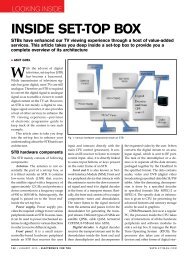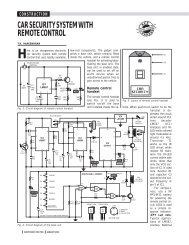ROBOTIC KITS - Electronics For You
ROBOTIC KITS - Electronics For You
ROBOTIC KITS - Electronics For You
Create successful ePaper yourself
Turn your PDF publications into a flip-book with our unique Google optimized e-Paper software.
BUYERS’<br />
GUIDE<br />
<strong>ROBOTIC</strong> <strong>KITS</strong><br />
There is a high demand for programmable bots that can be interfaced to different<br />
motors and sensors<br />
The types of robotics kits<br />
available in India have<br />
grown rapidly in the last<br />
four to fi ve years. The main<br />
consumers are students,<br />
mostly the engineering students, and<br />
hobbyists.<br />
Robotic kits help you to understand<br />
the concepts behind the robots<br />
and robot building in a concise manner.<br />
These also let you program the<br />
robot using simple visual programming<br />
languages, helping you to have a<br />
structured thinking towards problem<br />
solving.<br />
Many types of robotic kits are<br />
available, including toy kits, hobby<br />
kits and educational kits. In other<br />
words, all kinds of machines that are<br />
used to play with, experiment on and<br />
educate, consist of robotic kits. These<br />
may range from simple wheeled robots<br />
to complex robots such as humanoids,<br />
and from simple remote-controlled to<br />
PC-controlled robots.<br />
Do-it-yourself (DIY) kits are targeted<br />
at those who want to learn how<br />
to construct a robot. These usually<br />
come with a small handbook explaining<br />
how to put together the spare<br />
parts provided in the box. On the<br />
other hand, preassembled kits are for<br />
those who want to learn to program a<br />
robot or use a robot for their own research<br />
applications. These come with<br />
hardware schematics to explain the<br />
circuits and good documentation for<br />
Style<br />
POPULARITY ON RISE<br />
� UMA BANSAL<br />
Qu-Bot from Robokits<br />
programming interfaces.<br />
User-confi gurable robots can be<br />
classifi ed into three different sectors,<br />
viz, consumer, industrial and toys.<br />
Toy robots are experiencing a boom.<br />
Easily reconfi gurable toy robot kits are<br />
widely being used by youths for different<br />
competitions.<br />
<strong>You</strong> should prefer those kits which<br />
give lots of features at low price and<br />
are easy to build and learn. Line-follower<br />
or remote-controlled robotic kits<br />
are not programmable and generally<br />
have a single function, but these are<br />
affordable. Also available are imported<br />
kits like LEGO, robonova humanoid,<br />
robotic arm and hexapods, which are<br />
really good but costly.<br />
Robotic kits in India are offered by<br />
players like MacNet Technology, Energid<br />
Technologies, Rhydo Technologies,<br />
Kits‘n’Spares (an EFY associate),<br />
ThinkLABS, Techtronics Education,<br />
Robokits, Robosoft Systems, Gridbots<br />
Technologies and NEX Robotics.<br />
Target groups<br />
Main buyers of robotic kits in India<br />
are engineering students. Making<br />
these programmable mechanical devices<br />
helps them in understanding<br />
and conceptualising the theories involved.<br />
Outside India, the consumers<br />
are mostly hobbyists and researchers.<br />
In terms of target groups, the robots<br />
are being offered for:<br />
1. Children up to the age of 16 and<br />
their parents<br />
2. Schools<br />
3. Engineering students and hobbyists<br />
84 JULY 2010 ELECTRONICS FOR YOU WWW.EFYMAG.COM
Buyers’<br />
Guide<br />
Vegakits plastic body robot<br />
4. Professional colleges<br />
5. Entertainment industry<br />
building blocks<br />
Robotic kits are great integrators as<br />
they give insights into the fields of<br />
mechanics, electronics as well as programming.<br />
Most kits are intended for<br />
easy assembly. Some kits come with<br />
their own software, while some use<br />
commonly available software.<br />
Robotic hardware kits can be<br />
mechanically configured to enable<br />
different types of manipulation and<br />
locomotion. Electronic modules can be<br />
used to control the mechanics through<br />
actuators as well as to gather information<br />
from the hardware and the<br />
environment with the help of sensors.<br />
Software can be used to add behaviour<br />
and intelligence.<br />
The kit may include the brain of<br />
the robot, motors, different types of<br />
Boe-Bot robot kit from rhydoLABZ<br />
sensors (light, sound, bump, distance,<br />
etc) and mechanical parts like links,<br />
wheels and gears. It can be used to create<br />
different intelligent machines, be it<br />
an obstacle avoider, automatic crane or<br />
garbage collector.<br />
The mechanical structure of the kit<br />
acts as a chassis or body of the robot.<br />
The electronic controller board controls<br />
all the electromechanical parts<br />
and inherits the logic part of the robot.<br />
Sensors/actuators and other interface<br />
devices help the robot to connect to the<br />
world, by sensing it and then taking<br />
action as a response to the stimulus.<br />
Sensors use transducers to change the<br />
input signal (sound, light, pressure,<br />
temperature, etc) into an analogue or<br />
digital form capable of being used by<br />
the robot.<br />
A variety of electric motors provide<br />
power to robots, allowing them to<br />
move material, parts, tools or special-<br />
ised devices with various programmed<br />
motions.<br />
generally, two types of batteries<br />
are used to provide power supply: Primary<br />
batteries are used once and then<br />
discarded. Secondary batteries operate<br />
from a (mostly) reversible chemical<br />
reaction and can be recharged several<br />
times.<br />
Software tools come with application<br />
software to configure, sequence<br />
and also develop and download algorithms<br />
into the robot. High-end<br />
software tools<br />
do simulation<br />
and 3D visualisation<br />
to assist the entire robot<br />
development life-cycle.<br />
Microcontrollers (MCUs) are<br />
intelligent electronic devices used<br />
inside robots. A microcontroller takes<br />
input from the device and controls it by<br />
sending signals to different components<br />
Many vendors<br />
are selling<br />
cheap,<br />
unbranded<br />
robotic items.<br />
Many Chinese items have<br />
also come into the market.<br />
These vendors have no<br />
knowledge of robotics. —Ajit<br />
Vira, general manager, MacNet Technology<br />
in the device. Robotic kits use various<br />
platforms such as 8051, AVR and even<br />
32-bit ARM processor. These perform<br />
various functions ranging from path<br />
planning, vision-based processing to<br />
Swarm behavioural functions. <strong>For</strong> programming,<br />
generally, any ‘C’ compiler<br />
Most of the kits that contain microcontrollers<br />
can be interfaced with PCs, Ethernet modules,<br />
Zigbee wireless modules, sensors, etc. —Sandeep<br />
Vaidya, R&D head, Robokits India<br />
is preferred.<br />
The LEgO Mindstorms platform<br />
comes with the LEgO plug-and-play<br />
guarantee. LEgO parts are used for the<br />
assembly and creation of robots. The<br />
LEgO controller is an ARM-based controller<br />
that can be programmed using a<br />
USB or a Bluetooth connection. Many<br />
different kinds of environments are<br />
available for programming, including<br />
LabView, C, C++ and Java. Support<br />
Components of a<br />
standard kit<br />
1. Programmable platform (the logic<br />
processor of the bot)<br />
2. Motors (actuators to move the bot)<br />
3. Sensors (to gather information<br />
about surroundings)<br />
4. Power supply<br />
5. PC interface kit (to enable<br />
programming of the bot via PC)<br />
86 • July 2010 • electronics for you www.efymag.com
Make sure that<br />
the kits are<br />
expandable<br />
so that you<br />
can keep<br />
developing<br />
more and more complex<br />
projects. —Adwait Deshpande, R&D<br />
Head, Robotics Division, ThinkLABS, Sine<br />
IIT Mumbai<br />
for Microsoft Robotic Studio is also<br />
available.<br />
Functions depend on the type of<br />
the kit:<br />
• Wheeled robots: Remote control,<br />
sensor inputs, line following, motor<br />
encoders, LCD, switches, etc<br />
• Walking robots: Motion sequencing,<br />
balancing, etc<br />
• UAVs and fully autonomous outdoor<br />
robots: gPS navigation and<br />
long-distance communications<br />
The modularity of the hardware<br />
and user-friendliness of the software<br />
encourage users to try out more and<br />
more complex contraptions.<br />
Most of the robotic kits are USBcompatible<br />
for reprogramming. Hardware<br />
structure of certain models can<br />
be assembled in multiple ways, so you<br />
can construct different robots using the<br />
same parts.<br />
Robotic kits are available in a<br />
ThinkLABS’ iBot microcontroller-based autonomous robotic<br />
development platform<br />
www.efymag.com<br />
Style<br />
Fire Bird V ATMEGA2560 hexapod<br />
from NEx Robotics<br />
compact form and are easy to interconnect.<br />
There will be specification and<br />
directions for each and every part, so<br />
little effort is required to develop an<br />
amazing robot. gUI-based programming<br />
software that come along with<br />
the kit let you develop a robotic application<br />
by means of the mouse pointer<br />
(requiring only clicks and drags). Usually,<br />
robotic kits come with shaped<br />
parts of the robots having specific part<br />
numbers and associated motors, along<br />
with the motor holder. The kit consists<br />
of separate packets of assembly<br />
tools and instructions.<br />
Software support<br />
makes the assembly easy.<br />
User manual illustrates<br />
assembly step by step<br />
with figures. Certain robots<br />
need pre-correction<br />
of the motors and there<br />
are software tools to do<br />
this job.<br />
Functionalities<br />
in demand<br />
Basic functionalities like<br />
sensor interfacing, motor<br />
Buyers’<br />
Guide<br />
driving, servo driving and<br />
wireless command are in<br />
demand. Most buyers in India,<br />
at present, show interest<br />
in line-following or<br />
maze-solving robots.<br />
These robots<br />
need reconfigurable<br />
maze-solving algorithm.<br />
The robot program consists of<br />
different algorithms and the<br />
user can easily reconfigure the<br />
path using the interfacing<br />
software. gUIs developed<br />
in ROSSUM, XRCL or .NET<br />
with the help of compiler (for micro<br />
programming) is used to develop this<br />
interface.<br />
There is a high demand for modular<br />
robotic kits. A modular robotic<br />
kit is a programmable bot that can<br />
be interfaced to different motors and<br />
The level of difficulty is increasing<br />
from doing just line-following<br />
and obstacle-avoiding. —(L) Fahad<br />
Azad, Co-founder, Robosoft Systems, and (R)<br />
Syed Ross Farooq, Founder, Robosoft Systems<br />
sensors. It is generally, but not necessarily,<br />
a two-wheeled robot with<br />
facilities of multiple sensor interface,<br />
wireless communication and PC<br />
interface.<br />
level of autonomy<br />
The robots now developed in India<br />
use different sensors (such as proximity<br />
sensors and polarisation sensors)<br />
to maintain the balance of the robot<br />
and give direction to its path. Balancing<br />
is an amazing process and hence<br />
most companies are focused on this<br />
function. Various input applications<br />
like voice processing, image processing<br />
and multiple sensor reading and<br />
response are already implemented. But<br />
certain materials for manufacturing<br />
specialised robots like wall-climbing<br />
robots are not available in India, and<br />
are very costly to import.<br />
System engineering of industrial<br />
electronics for you • July 2010 • 87
Buyers’<br />
Guide<br />
Global scenario<br />
The number of robots in the world today is approaching 1,000,000, with almost half<br />
that number in Japan and just 15 per cent in the US. A couple of decades ago, 90 per<br />
cent of robots were used in car manufacturing, typically on assembly lines doing a<br />
variety of repetitive tasks. Today, only 50 per cent are in automobile plants, with the<br />
other half spread out among other factories, laboratories, warehouses, energy plants,<br />
hospitals and many other industries. In the area of ‘electronic business,’ industrial<br />
robots are changing too. High competition existing in the global market requires ‘just<br />
in time’ products, better utilisation of raw materials, better utilisation of resources<br />
and lower consumption of energy. All these requirements imply new features for the<br />
industrial robots.<br />
The robotic kits market is primarily centred around recreation, service, and learning<br />
and research.<br />
Recreational robotics is becoming popular with robot competitions like robot soccer.<br />
This is particularly popular in Asian counties like Japan, Korea, Singapore, Taiwan and<br />
China. The current market share in this category is comparatively low now and is likely<br />
to diminish in a decade as robots become more common in our daily life and we lose<br />
excitement in their novelty. Kits in particular will find it difficult to catch this market due<br />
to their limited scope compared to research prototypes in this area.<br />
The future trend is definitely towards service robots, which are semi or fully<br />
autonomous and can provide useful services in support of humans and manufacturing<br />
environments. There will be a substantial increase in activity and build-up of this market.<br />
Here again finished products are expected to dominate kits.<br />
Coming to research and learning, there is a consistently growing market for robots<br />
and robotic kits in this space. As far as product development in this area is concerned,<br />
there is a need for adequate kits and spares to carry out the research and prototyping.<br />
Apart from that, robotic kits serve as a multidisciplinary learning tool for fundamentals<br />
such as mathematics, physics, and science, which again is a promising market. Here<br />
kits undoubtedly dominate any other specifically tailored product.<br />
robots around specific applications<br />
is a crucial area. Lack of the trained<br />
system engineering manpower and reluctance<br />
of the Indian industry to open<br />
to advanced methods of manufacturing<br />
have led to a stunted demand for<br />
industrial robots.<br />
Some of the advanced applications<br />
developed by Indian students<br />
can be seen in national-level competitions<br />
like Micromouse and Robocon.<br />
Maze solving, image processing and<br />
pick-and-place arms are some of the<br />
skills that we are evolving in. The<br />
level of expertise is increasing from<br />
just line-following and obstacleavoiding<br />
to swarm robotic behav-<br />
iour, which requires many robots<br />
to cooperate with each other to do a<br />
particular task.<br />
Trends world over<br />
Basic functionalities like sensor interfacing,<br />
motor driving, servo driving and wireless<br />
command are in demand. —Pulkit Gaur, Founder and<br />
Chief Technology Officer, Gridbots Technologies<br />
global trends also hint that preassembled<br />
robots are gaining more popularity<br />
and people usually use them as<br />
the first building block and develop<br />
applications over them, thus relieving<br />
them from the burden of building<br />
the chassis, finding a drive system and<br />
calibrating the system.<br />
The scenario outside India is different<br />
mainly because people are ready<br />
to go for advanced robots and the<br />
technology and sensors used in them.<br />
Some kits like<br />
Bioloid enable<br />
the user to<br />
configure his<br />
robot in 18<br />
different ways.—Jayakrishnan T.,<br />
Director and Country Manager, Energid<br />
Technologies<br />
They are ready to pay a high price<br />
for the same. Widely used robots are<br />
robotic arms, bipeds, humanoids and<br />
soccer robots.<br />
Competitions are and have always<br />
been an incentive to make robots, be it<br />
in India or Japan. The difference lies in<br />
the level of the competition. Robo Soccer<br />
is a popular competition in which<br />
a team of four robots play a game of<br />
soccer against another team. Flying<br />
robot competition and humanoid robo<br />
fighting championship are some other<br />
popular events.<br />
advances in hardware and<br />
software<br />
The electronic hardware keeps on<br />
advancing, nowadays in the form<br />
of complex sensors, communication<br />
systems and control systems. These<br />
technologies are definitely used in<br />
India but on a very small scale compared<br />
to other countries. However, a<br />
technology that is available in USA<br />
today can be made available in India<br />
tomorrow, thanks to global shopping<br />
sites like sparkfun.com and digikey.<br />
com.<br />
Application-wise, we are overcoming<br />
the not-so-huge gap between us<br />
and other advanced nations.<br />
A lot is happening in software<br />
development of the robotics. With the<br />
software available with robotic kits,<br />
the end user need not study the basics<br />
of microcontroller programming. He<br />
only needs to have a certain logical<br />
skill like what to do and what should<br />
be the end result.<br />
88 • July 2010 • electronics for you www.efymag.com
emphasis of<br />
design<br />
As in any other product,<br />
design plays a pivotal<br />
role in the success of robotic<br />
kits. The design is<br />
dependent on the target<br />
group. Kids want their<br />
kits to be colourful, easy<br />
to use and robust. Engineering<br />
students want<br />
the circuits to be open,<br />
the kit to be modular and<br />
facilities of add-on modules,<br />
whereas lab equip-<br />
ment should be robust and critical and<br />
circuits should be closed and secured.<br />
The other design considerations are<br />
design efficiency, economy, material/<br />
component availability, optimising<br />
manufacturing process, etc. If the design<br />
is targeted for Indian customers,<br />
the emphasis is on value for money.<br />
<strong>For</strong> international clients, the emphasis<br />
is on kits that solve complex problems.<br />
Cost of the robot can be reduced<br />
by changing the materials used in construction<br />
of body parts. Manufacturers<br />
study the end product and select the<br />
actuators and sensors that are best<br />
www.efymag.com<br />
Style<br />
Cyton I robot manipulator from Energid Technologies<br />
Hardware structure of certain models can be<br />
assembled in multiple ways, so that you can<br />
construct different robots using the same<br />
parts. —Thushar V. Nadh, Director-Technical, Rhydo Technologies<br />
sleuthHound automatic<br />
locking and tracking camera<br />
system from Gridbots<br />
suited for the robot. <strong>For</strong> example, certain<br />
robots need precision rather than<br />
speed. In that case, a stepper motor is<br />
used instead of servo or brushless DC<br />
motors.<br />
Cost has a direct relationship with<br />
quantity. In India, the demand in this<br />
segment is very low compared to other<br />
countries and hence the costs are quite<br />
high. However, with an increase in<br />
awareness and hence demand, prices<br />
of robotic kits will fall.<br />
To make the kits appealing to the<br />
Indian consumers, manufacturers need<br />
to come up with different kinds of<br />
Buyers’<br />
Guide<br />
electronics for you • July 2010 • 89
Buyers’<br />
Guide<br />
When<br />
purchasing a<br />
kit, make sure<br />
that it is at the<br />
right difficulty<br />
level for you. Also consider<br />
the number of sensors and<br />
number of building blocks<br />
in the kit.—Sachitanand Malewar,<br />
Director, NEX Robotics<br />
package deals. <strong>For</strong> example, instead of<br />
offering a bot with ten different kinds<br />
of sensors, they could offer a bot with<br />
four sensors and the rest six can be<br />
bought individually as add-ons.<br />
Displays, chips, networking, etc.<br />
Many of these kits use the technology<br />
that is currently being used in industries.<br />
Robotic kits for engineering students,<br />
in particular, are equipped with<br />
ultrasonic/infrared sensors, LCDs, latest<br />
microcontrollers, etc. Some of these<br />
technologies don’t even find a mention<br />
in the current academic syllabus.<br />
So the students are exposed to such<br />
devices and concepts through robotics<br />
and their personal projects.<br />
Most of the kits that use microcontrollers<br />
can be interfaced with PCs,<br />
Ethernet modules, Zigbee wireless<br />
modules, sensors, etc.<br />
Why is robotics not much<br />
popular in india?<br />
In countries like USA, Japan and<br />
Korea, most of the high-paying jobs<br />
are from high-tech R&D sectors and<br />
require constant innovation. As a<br />
developed country, there is a good<br />
emphasis on high-quality vocational<br />
training and universities have talented<br />
vocational teachers. Children<br />
are exposed to high-tech toys at a<br />
very young age. Students work overtime<br />
and use self-earned money for<br />
the hobby robotics, because of which<br />
they have bigger budget for their<br />
robotics projects.<br />
In India, we are experiencing all<br />
these things for the first time. Most of<br />
the critical electrical and mechanical<br />
components and systems, including<br />
harmonic drives, servo valves and<br />
cylinders, servo motors, controllers,<br />
encoders and position resolvers, are<br />
currently being imported, making the<br />
final product extremely expensive.<br />
Also, Indians feel alienated by the<br />
idea of robots replacing human labour.<br />
It does make sense that in an abundantly<br />
populated country like ours,<br />
robotics will not be preferred. But now<br />
people have started to understand the<br />
other uses of robots where humans<br />
need not be replaced. Fields like space<br />
exploration and defence can flourish<br />
with the use of robotics.<br />
advice to consumers<br />
All the robotics sets have instructions<br />
on how to build some basic robots.<br />
The keyword here is ‘build,’ because<br />
you will be building them. So make<br />
The LEGO Mindstorms NXT is based on the<br />
ARM processors. All sensors are I 2 C-compliant<br />
and motors are geared servo motors with<br />
built-in PID controllers.—Sudhanshu Sharma, managing<br />
director, Techtronics Education<br />
sure that this is what you want. When<br />
purchasing a kit, make sure that it is<br />
at the right difficulty level for you.<br />
Also consider the number of sensors<br />
and number of building blocks in the<br />
kit.<br />
Specifications play a very important<br />
role. Make sure you have the<br />
right specifications before you order<br />
online (or offline). In particular, pay<br />
attention to following features of the<br />
kit: Programmability and ease of use,<br />
number of sensors and type of sensors<br />
used, type of batteries and motors<br />
used, applications and functionalities<br />
of the robot, number of degrees of<br />
freedom in case of robotic arms and<br />
walking robots, communication systems<br />
and cost.<br />
Look at the safety features too.<br />
Many a times, robotic kits are sold with<br />
lots of claims that are not true. Robots<br />
often have insufficient battery power;<br />
the battery becomes unusable after a<br />
few days of use. So avoid buying kits<br />
that use low-cost lithium-ion/NiMH<br />
batteries from grey market. These may<br />
not have proper battery protection and<br />
come with low-cost battery chargers.<br />
In such cases, it is very likely that the<br />
battery will explode and cause serious<br />
injuries after a few charge-discharge<br />
cycles. Transistorised motor drivers too<br />
can blow if not handled properly. Buy<br />
gear motors, which have black gear<br />
box and are more reliable.<br />
Look for scalability in terms of addons.<br />
Buy a kit that is multifunctional,<br />
expandable and reprogrammable so<br />
that you can keep developing more<br />
and more complex projects. <strong>For</strong> example,<br />
a simple line-follower robot kit<br />
or mobile-operated robot kit will be<br />
nothing but a toy after some time of<br />
usage. A microcontroller-based robot<br />
kit or a programmable walking robot<br />
kit, on the other hand, will give good<br />
knowledge, offer continuous entertainment<br />
and learning, and can be used in<br />
making more advanced robots.<br />
Ensure that the kit comes with a<br />
well-documented manual or a training<br />
programme.<br />
An ideal hobby kit would be a microcontroller<br />
development board with<br />
schematic, standard sensors, reliable<br />
wireless modules, DC motors with encoders<br />
and a USB interface. The development<br />
board helps to interface many<br />
different kinds of peripherals that you<br />
can develop yourself. �<br />
The author is a deputy editor at EFY<br />
90 • July 2010 • electronics for you www.efymag.com








